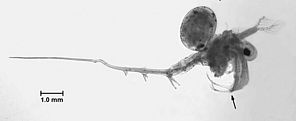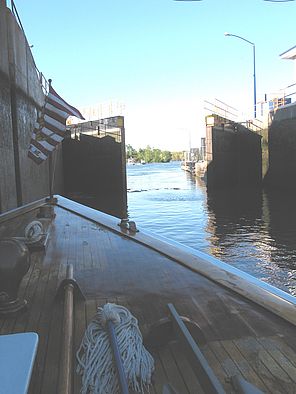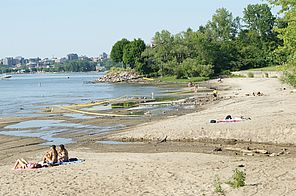State of the Lake
How is Lake Champlain doing? The Lake Champlain Basin Program released a new State of the Lake report this summer that helps answer that question. The State of the Lake comes out every three to four years to report on progress meeting water protection and restoration goals, track changes in the lake’s condition, and answer frequently asked questions. Topics covered include phosphorus, human health and toxins, biodiversity and aquatic invasive species, climate change, 2011 flooding, and recreation and tourism. Read about the progress and shortfalls and download a copy.
Spiny Waterflea Spreads to Lake George
The spiny waterflea, an invasive plankton species, was found in Lake George in early August. The species was found from at least four different locations in the lake in both the South Basin and in northern stretches. Now they have a direct connection to Lake Champlain from Lake George via the LaChute River.
Spiny waterfleas were first discovered when an angler brought specimens to the Darrin Freshwater Institute. Officials estimate that the spiny waterflea may have been in Lake George a year or two before they were detected. Learn why spiny waterflea are a concern and send a message to the New York Canal Corporation to act.
On Closing the Champlain Canal
When New York Governor Andrew Cuomo was still Attorney General, he weighed in on the side of Michigan when they called for Illinois to sever a century-old Chicago Canal because of the threat that Asian carp would move from the Mississippi River drainage into the Great Lakes drainage. Now, Lake Champlain is threatened by an invasive species, the spiny waterflea, which is found in the Champlain Canal. It will be interesting to see how adamant the Governor is when the threat of invasive species occurs in his own backyard and in a canal system under his authority. Read on for why closing the canal link is key to protecting the lake from new invasive species.
LCC Tackling Invasives
The Lake Champlain Committee continues our collaboration with Arrowwood Environmental to map vegetation in Lake Champlain, identify invasive species populations, and eradicate any newly established populations. In addition we will produce maps of the plant communities present. This year work is concentrated in the Northeast Arm of the lake. So far, no new invasive populations have been found, though Eurasian watermilfoil is scattered at low densities throughout the area. The project is a continuation of work begun last summer in Missisquoi Bay and is funded by Green Mountain Coffee Roasters and the Lake Champlain Basin Program.
“Not only will we offer on the ground rapid response to any new invasive plants, we’ll also provide baseline data so future lake managers can understand how the plant communities have changed as a result of climate change, species invasions, or whatever else might affect the lake,” said LCC Staff Scientist Mike Winslow.
IJC Holds Lake Flooding Hearings
The International Joint Commission (IJC) has been charged with defining a scope of work for a study or studies needed to address lake flooding. The charge follows record lake flooding in the spring of 2011. The IJC recently held public hearings in Saint-Paul-de-I’lle-aux-Noix, Quebec and North Hero, Vermont. At the North Hero meeting LCC made it clear that we would not support efforts to regulate Lake Champlain. Any proposed structural means of dealing with lake flooding should begin and end with an examination of the ChamblyCanal which was widened in the 1970s causing Lake Champlain to drain more slowly during high water periods.
Additionally, we urged the IJC to focus on recommending appropriate lakeshore development regulations and to support the Lake ChamplainBasin’s existing stream gaging network. The stream gaging network is vitally important for predicting flooding throughout the Basin and giving residents an opportunity to prepare for floods. Funding to continue the gaging has been tenuous in recent years.
Plattsburgh’s Drug Box Protects Public Safety and Water Quality
Plattsburgh New York residents can safely dispose of expired, un-used or unwanted medications thanks to a new drug drop box located at the City Police Department on 45 Pine Street. The drop box was initiated by Plattsburgh Police Chief Desmond Racicot and Lt. Pat Rascoe after they saw one displayed at an international police chief’s conference earlier this year.
Proper disposal of pharmaceuticals is garnering attention as communities struggle to combat prescription drug abuse and protect waterways from contamination. Leftover medicines should be removed from medicine cabinets to avoid ending up in the wrong hands. They should also never be dumped down the toilet or the drains as they can pollute water systems. Read more about Plattsburgh's drug drop box success.
National Prescription Drug Take Back Day September 29, 2012
Federal and state agencies are teaming up to host a National Prescription Drug Take Back Day on Saturday, September 29, 2012 from 10:00 AM until 2:00 PM. LCC encourages everyone to check medicine cabinets for unwanted, unused pharmaceuticals and safely dispose of them at a nearby collection site. More than 1.5 million pounds of medication were removed from circulation during four previous National Take Back Days.
- Click here and choose your zip code, county, city or state to find a take back location near you.
Eco-Fest – September 8!
The 7th Annual Eco-Fest takes place Saturday, September 8 from 11:00 AM until 5:00 PM at the Lake Champlain Community Sailing Center. Wander down to the Burlington waterfront for live music, good food, and to learn about regional conservation efforts. There will be equipment demos, short informational talks running every hour, and tips for environmental stewardship. A silent auction will raise money for LCC and other good causes!
LCC Staff Scientist Mike Winslow will be on hand at our display to answer your lake questions. This fun, educational community event is organized by the Outdoor Gear Exchange and will take place along side the Stand Up for the Lake paddleboard festival which will include paddle boarding demos, lessons, and races.
Capital to Capitol Paddle En Route to DC
On September 5 a group of paddlers set off from Ottawa Ontario in a voyageur canoe bound for Washington DC. They will follow an 1800 kilometer route on rivers, lakes and canals to learn more about local water issues and stimulate greater civic engagement and collaboration in protecting water resources. The voyage is a project of the Canadian Wildlife Federation.
Traditionally, voyageur canoes carried cargos of furs and trade goods. But according to organizers, the Capital to Capitol canoe carries a different kind of payload – a dream that Canada and the United States will work together to protect and restore the waterways that connect us. LCC is assisting with the group’s paddle on Lake Champlain where they hope to arrive around September 14. Click here to learn more about the Capital to Capitol endeavor and follow their journey.
The Low-down on Low Lake Levels
What a difference a year makes! While the spring of 2011 brought record high lake levels, the summer of 2012 will be remembered for how low the lake dropped. As of August 31 the lake stood at 94.19 feet, about a foot and a half below average for this time of year. This is the lowest the lake has been since January of 2002. Typically the lake level continues to drop until October. The lowest lake level ever recorded was in 1908, a year which recorded monthly low water records from October through January of 1909. The lowest point came on December 4th when the lake dropped to 92.61 feet. Read more about lake levels.
Nature Notes - Bonaparte’s Gulls
Starting in August and through the migration period, Lake Champlain’s smallest gull arrives, the Bonaparte’s gull. These are small graceful gulls with slender black beaks that sometimes act like terns, diving into the water. During the breeding season they sport an all black head. As winter comes on the head becomes mostly white, receding to a black spot behind the ear. Juveniles also lack the distinctive black head.
Bonaparte’s gulls breed in the boreal forests of the north; they are the only gulls that actually nest in trees rather than on the ground. They were named for Napoleon’s nephew, Charles Lucien Bonaparte, a 19th century ornithologist in America and Europe.
Like LCC on Facebook!
LCC is now on Facebook! We invite you to 'like' LCC's Facebook page. It's a great way to get the latest lake news, blue-green algae monitoring updates, beautiful lake photos, and other engaging content.
Here's how to like the Lake Champlain Committee on Facebook:
- Click the "Like" button
- If you aren't logged into your Facebook account, you may be prompted to log in
- Enjoy frequent lake updates and LCC news
Moving? Changing Email Addresses?

If you’ve changed your address recently, please send us an email so we can update your files and ensure you receive news on lake issues and LCC’s work. Email is our primary form of communication with members. Mailing electronically saves time and resources and reinforces the stewardship ethic of our mission. We don’t give away or sell email addresses.
To ensure you receive email from LCC, please add lcc@lakechamplaincommittee.org and the domain enews.lakechamplaincommittee.org to your safe/allowed list and address book. Thanks!
Lake Champlain Committee Board of Directors
Gary Kjelleren - Chair (South Hero, VT), Sharon Murray - Treasurer (Bolton, VT), Alan Booth (Plattsburgh, NY), Sandy Montgomery (Montreal, QC), Ann Ruzow Holland (Willsboro, NY), Mary Van Vleck (Charlotte, VT), Chuck Woessner (Grand Isle, VT).
Lake Champlain Advisory Council
Megan Epler Wood (Burlington, VT), Steven Kellogg (Essex, NY), Peter S. Paine, Jr. (Willsboro, NY), Mary Watzin (Burlington, VT).
Lake Champlain Committee Staff
Lori Fisher, Executive Director
Jessica Rossi, Office Manager
Mike Winslow, Staff Scientist














